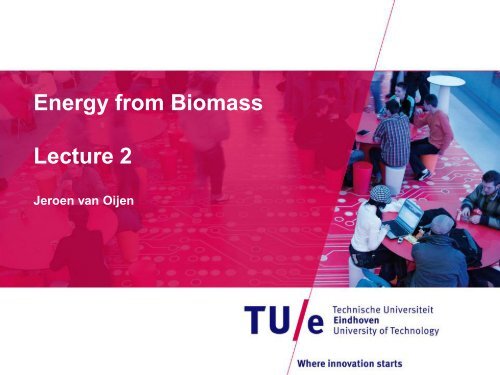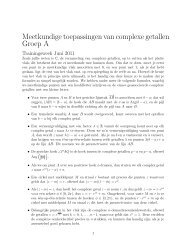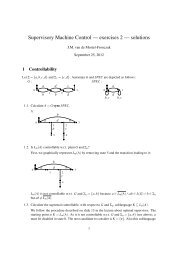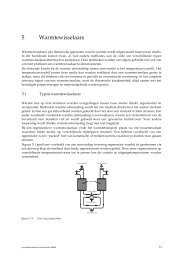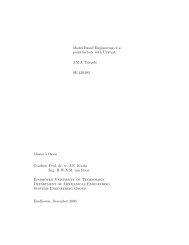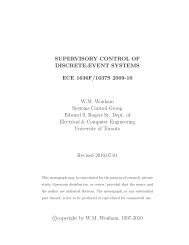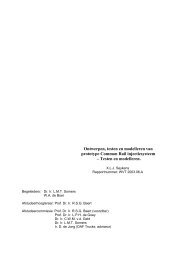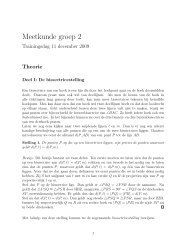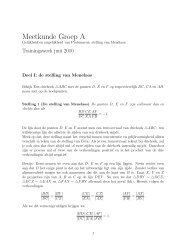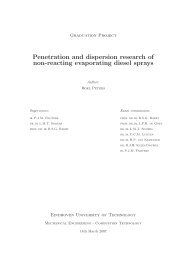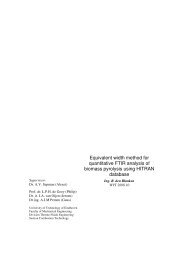O - Mechanical Engineering
O - Mechanical Engineering
O - Mechanical Engineering
You also want an ePaper? Increase the reach of your titles
YUMPU automatically turns print PDFs into web optimized ePapers that Google loves.
Energy from biomassCourse outline1. Biomass macro systems Global warming and resources‣ Biomass properties and characterization‣ Conversion processes2. Biomass micro systems3. Practical work/ <strong>Mechanical</strong> <strong>Engineering</strong> 18-11-2011 PAGE 2
Characteristics of biomass fuels• Wide range of fuel types• Important for• Conversion technology• Plant design• Homogeneity• Economy of scales• Standardization• CEN, ISO, DIN, ASTM/ <strong>Mechanical</strong> <strong>Engineering</strong> 18-11-2011 PAGE 4
Biomass properties• Internet databases• ECN www.ecn.nl/phyllis• DoE Biomass program• Wood (untreated, treated)• Grass• Manure• Waste• Sludge• Straw• Husk/shell/pit• Organic residue• Algae• Vegetable oil/ <strong>Mechanical</strong> <strong>Engineering</strong> 18-11-2011 PAGE 5
Physical characteristics (1)Moisture contentStorage, dry-matter lossesVolatile content/compositionAsh contentThermal decomposition,combustion technologyDust emission, ash manipulationFixed carbonCombustion technologyCalorific/HeatingValueFuel utilization, plant design/ <strong>Mechanical</strong> <strong>Engineering</strong> 18-11-2011 PAGE 6
Physical characteristics (2)Ash meltingSafety, process controlFungiHealth risksBulk densityLogisticsParticle density, heatcapacity, conductivityDimension, shape,distributionThermal decompositionConveying, drying, bridging,combustion technology/ <strong>Mechanical</strong> <strong>Engineering</strong> 18-11-2011 PAGE 7
Chemical properties / elements (1)Carbon CHydrogen HOxygen ONitrogen NChlorine ClSulphur SFluor FHeating ValueHeating ValueHeating ValueNO x , N 2 O emissionsHCl, PCDD/F emissions, corrosionSO x emissions, corrosionHF emissions, corrosion/ <strong>Mechanical</strong> <strong>Engineering</strong> 18-11-2011 PAGE 8
Chemical properties / elements (2)Potassium KSodium NaMagnesium MgCalcium CaPhosphor PHeavy metalsCorrosion, ash meltingCorrosion, ash meltingAsh melting, utilizationAsh melting, utilizationAsh utilisationEmission, ash melting/ <strong>Mechanical</strong> <strong>Engineering</strong> 18-11-2011 PAGE 9
Structure of woodSoftwoodHardwood/ <strong>Mechanical</strong> <strong>Engineering</strong> 18-11-2011 PAGE 10
Composition of woody biomassTracheids/ <strong>Mechanical</strong> <strong>Engineering</strong> 18-11-2011 PAGE 11
Composition of woody biomassCombination of three CHO components1. Cellulose2. Hemicellulose3. Lignin/ <strong>Mechanical</strong> <strong>Engineering</strong> 18-11-2011 PAGE 12
Composition of woody biomass1. Cellulose (C 6 H 10 O 5 ) n• Structure, fibre walls• Carbohydrate (sugar)• Polymer of glucose C 6 H 10 O 6/ <strong>Mechanical</strong> <strong>Engineering</strong> 18-11-2011 PAGE 13
Composition of woody biomass2. Hemicellulose (C 5 H 8 O 4 ) n• Encasing of cellulose fibre• Carbohydrate• Other than glucose• Dissolvable/ <strong>Mechanical</strong> <strong>Engineering</strong> 18-11-2011 PAGE 14
Composition of woody biomass3. Lignin (C 40 H 44 O 6 )• Binding agent / strength• Non-sugar polymer• Aromatic structure/ <strong>Mechanical</strong> <strong>Engineering</strong> 18-11-2011 PAGE 15
Composition of woody biomassCellulose Hemicellulose LigninBeech 45.2 32.7 22.1Birch 44.5 36.6 18.9Pine 45.0 26.4 28.6Spruce 48.5 21.4 27.1/ <strong>Mechanical</strong> <strong>Engineering</strong> 18-11-2011 PAGE 16
Characterization methods• Proximate analysis• Moisture content• Volatile matter• Fixed carbon• Ash content• Ultimate analysis• C, H, O, N, S, …• Bomb calorimeter• Calorific/Heating value/ <strong>Mechanical</strong> <strong>Engineering</strong> 18-11-2011 PAGE 17
Proximate analysis• Place biomass sample on a scale in an oven filled with inert gas• Heat up to 110˚C → moisture evaporates• Measure weight loss → moisture content• Wet basis:• w = (wet weight-dry weight)/wet weight• Dry basis:• u = (wet weight-dry weight)/dry weight• Conversion:• w = u/(1+u) u = w/(1-w) u > w/ <strong>Mechanical</strong> <strong>Engineering</strong> 18-11-2011 PAGE 18
Moisture contentMoisture content may vary a lot/ <strong>Mechanical</strong> <strong>Engineering</strong> 18-11-2011 PAGE 19
Proximate analysis continued• Sample is heated (carbonized) to 950˚C• Volatile matter (VM) is released from sample• Tar: monomers of (hemi)cellulose, lignin polymers• Gas: CO, H 2 , CH 4 , CO 2 , H 2 O…• Weight loss gives VM contentY VM = weight loss / dry weight(wt % d.b.)/ <strong>Mechanical</strong> <strong>Engineering</strong> 18-11-2011 PAGE 20
Proximate analysis continued• Air is allowed to enter the system• The sample burns and ash remains• Ash contentY Ash = weight ash / dry weight(wt % d.b.)• Fixed carbon content determined by differenceY FC = 1 - Y VM - Y Ash(wt % d.b.)/ <strong>Mechanical</strong> <strong>Engineering</strong> 18-11-2011 PAGE 21
Proximate analysesVM FC Ash VM FC Ash/ <strong>Mechanical</strong> <strong>Engineering</strong> 18-11-2011 PAGE 22
Thermo-Gravimetric Analysis (TGA)• Put sample in inert atmosphere• Pure nitrogen N 2• Slowly heat up sample• Heating rate ~20 °C/min• Measure weight loss as function of time• Typical result…/ <strong>Mechanical</strong> <strong>Engineering</strong> 18-11-2011 PAGE 23
Weight (%)Temperature (°C)TGA of pine barkSample: Bark 90 micronSize: 4.8961 mgMethod: BiomassComment: first test120DSC-TGAFile: C:\TA\Data\TGA\Bark90micron.002Operator: AdrianRun Date: 5-Nov-03 13:5860010010.47% moisture(0.5128mg)8040049.41% Volatiles(2.419mg)604020037.96% F.C.(1.858mg)200Residue:2.037% Ash(0.09972mg)00 20 40 60 80 100 120Time (min)Universal V3.0G TA Instruments/ <strong>Mechanical</strong> <strong>Engineering</strong> 18-11-2011 PAGE 24
Results of pine bark% Wet % Dry % DAFMoisture 10.5 - -Ash 2.1 2.3 -Volatile Matter 49.4 55.2 56.5LowFixed Carbon 38.0 42.4 43.4/ <strong>Mechanical</strong> <strong>Engineering</strong> 18-11-2011 PAGE 25
Derivative TGA curveCelluloseHemicelluloseLignin/ <strong>Mechanical</strong> <strong>Engineering</strong> 18-11-2011 PAGE 26
TGA and DTG for softwood biomass/ <strong>Mechanical</strong> <strong>Engineering</strong> 18-11-2011 PAGE 27
TGA and DTG for hardwood/ <strong>Mechanical</strong> <strong>Engineering</strong> 18-11-2011 PAGE 28
Fitting a devolatilization model/ <strong>Mechanical</strong> <strong>Engineering</strong> 18-11-2011 PAGE 29
Exam questionSample is put in N 2 filledfurnace. After 45 min. thetemperature is increased to110 ℃. After 30 min. it isslowly increased to 600 ℃.Finally, air is supplied.a) Explain the curve.b) Determine compositionon wet basis, and dryand-ash-freebasis./ <strong>Mechanical</strong> <strong>Engineering</strong> 18-11-2011 PAGE 30
Answer/ <strong>Mechanical</strong> <strong>Engineering</strong> 18-11-2011 PAGE 31
Ultimate analysis• Sample is burned in O 2 atmosphere with He ascarrier gas• Combustion gases are CO 2 , H 2 O, NO, NO 2 , SO 2 , SO 3and N 2• SO 3 , NO and NO 2 are reduced at copper contact toSO 2 and N 2• H 2 O, SO 2 and CO 2 are captured in differentadsorption columns/ <strong>Mechanical</strong> <strong>Engineering</strong> 18-11-2011 PAGE 32
Ultimate analysis continued• N 2 is not captured and is detected by a thermalconductivity detector (TCD)• N 2 → N• Consecutively, H 2 O, SO 2 and CO 2 will be sent to TCD• H 2 O → H• SO 2 → S• CO 2 → C• Mass percentage is determined integrally• O is found by difference/ <strong>Mechanical</strong> <strong>Engineering</strong> 18-11-2011 PAGE 33
Ultimate analyses/ <strong>Mechanical</strong> <strong>Engineering</strong> 18-11-2011 PAGE 34
Coalification (Van Krevelen) diagram/ <strong>Mechanical</strong> <strong>Engineering</strong> 18-11-2011 PAGE 35
Gross calorific / Higher heating value• Empirical relation for biomassGCV = 34.91 Y C + 117.83 Y H + 10.05 Y S– 1.51 Y N – 10.34 Y O – 2.11 Y ash [MJ/kg d.b.]Y i is content in wt% d.b.Calculation exercise for CH 1.0 O 0.4375/ <strong>Mechanical</strong> <strong>Engineering</strong> 18-11-2011 PAGE 36
Bomb calorimeterDevice to measureheating value/ <strong>Mechanical</strong> <strong>Engineering</strong> 18-11-2011 PAGE 37
Effect of moisture on heating value• Gross Calorific Value (GCV) Higher Heating Value (HHV)• Heat released during combustion per mass unit fuel• Final temperature same as initial temperature• Water is formed in liquid phase• Net Calorific Value (NCV)• Water is formed in gaseous phaseLower Heating Value (LHV)• Latent heat + sensible heat (100-25℃)/ <strong>Mechanical</strong> <strong>Engineering</strong> 18-11-2011 PAGE 38
Net calorific valueDerived from GCV18NCV ( GCV 2.442 h)*(1 w) 2.442w2[MJ/kg d.b.]w = water content wt% w.b.h = hydrogen concentration wt% d.b. (~6%)Calculation exercise for dry CH 1.0 O 0.4375/ <strong>Mechanical</strong> <strong>Engineering</strong> 18-11-2011 PAGE 39
Ash• Inherent ash versus entrained ash• Bottom ash versus fly ash• Constituents• Plant nutrients: CaO, MgO, K 2 O,P 2 O 5 , Na 2 O• Other oxides: SiO, Al 2 O 3 , Fe 2 O 3• Heavy metals: Cu, Zn, Cr• Organic contaminants: PCDD/Fand PAH/ <strong>Mechanical</strong> <strong>Engineering</strong> 18-11-2011 PAGE 40
Ash melting behavior• Sintering: agglutination of particles• Softening temperature: change of surface, rounding,shrinking.• Hemisphere temperature: spherically shaped• Melting temperature: size reduced to 1/3• Ca and Mg increase• K and Na decrease/ <strong>Mechanical</strong> <strong>Engineering</strong> 18-11-2011 PAGE 41
Improving biomass quality• Growing phase• Harvesting date (moisture)• Fertiliser (Cl in straw)• Rainfall during storage on the field• Supply phase: Upgrading• Increase energy density• More homogeneous− Chunking, chipping, grinding− Drying− Compressing (pellets and briquettes)/ <strong>Mechanical</strong> <strong>Engineering</strong> 18-11-2011 PAGE 42
Leaching of barley straw by rainfall/ <strong>Mechanical</strong> <strong>Engineering</strong> 18-11-2011 PAGE 43
Conversion processes/ <strong>Mechanical</strong> <strong>Engineering</strong> 18-11-2011 PAGE 44
Biomass conversion routes/ <strong>Mechanical</strong> <strong>Engineering</strong> 18-11-2011 PAGE 45
Thermochemical conversion• Advantage: High throughput• Three main processes• Pyrolysis Air ratio = 0• Gasification Air ratio = 0.25 – 0.50• CombustionAir ratio = 1 – inf.• Difference: the amount of oxidizer (air) availableAir ratio =Actual air fuel ratioAir fuel ratio for stoichiometric combustion/ <strong>Mechanical</strong> <strong>Engineering</strong> 18-11-2011 PAGE 46
Questions/ <strong>Mechanical</strong> <strong>Engineering</strong> 18-11-2011 PAGE 47


